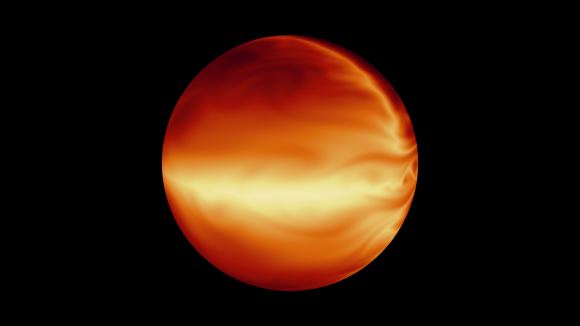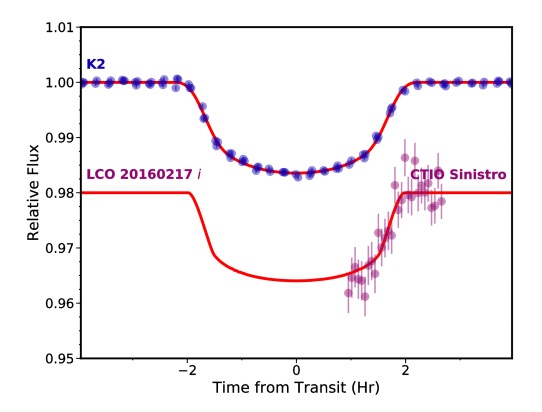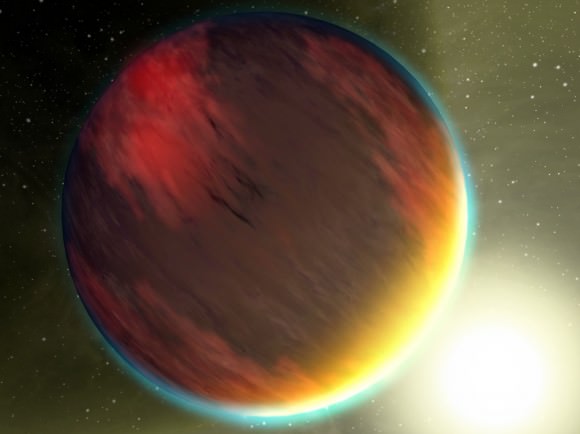The study of extra-solar planets has turned up some rather interesting candidates in the past few years. As of August 1st, 2017, a total of 3,639 exoplanets have been discovered in 2,729 planetary systems and 612 multiple planetary systems. Many of these discoveries have challenged conventional thinking about planets, especially where their sizes and distances from their suns are concerned.
According to a study by an international team of astronomers, the latest exoplanet discoveries are in keeping with this trend. Known as EPIC 211418729b and EPIC 211442297b, these two gas giants orbit stars that are located about 1569 and 1360 light-years from Earth (respectively) and are similar in size to Jupiter. Combined with their relatively close orbit to their stars, the team has designated them as “Warm Jupiters”.
The study, titled “EPIC 211418729b and EPIC 211442297b: Two Transiting Warm Jupiters“, recently appeared online. Led by Avi Shporer – a postdoctoral scholar with the Geological and Planetary Sciences (GPS) division at the California Institute of Technology (Caltech) – the team relied on data from the Kepler and K2 missions, and follow-up observations with multiple ground-based telescopes, to determine the sizes, masses and orbits of these planets.
Simulation of the turbulent atmosphere of a hot, gaseous planet, based on data from NASA’s Spitzer Space Telescope. Credits: NASA/JPL-Caltech/MIT/Principia College
The team then conducted follow-up observations using the Keck II telescope (located at the W.M. Keck Observatory in Hawaii) and the Gemini North Telescope (at the Gemini Observatory, also in Hawaii). These observations, conducted from January 2016 to May 2017, were then combined with spectral data and radial velocity measurements from the High Resolution Echelle Spectrometer (HIRES) the on the Keck I telescope.
Finally, they added photometric data from the Cerro Tololo Inter-American Observatory (CTIO) in Chile, the South African Astronomical Observatory (SAAO), and the Siding Spring Observatory (SSO) in Australia. These follow-up observations confirmed the presence of these two exoplanets. As they wrote in the study:
“We have discovered two transiting warm Jupiter exoplanets initially identified as transiting candidates in K2 photometry… Both planets are among the longest period transiting gas giant planets with a measured mass, and they are orbiting relatively old host stars. Both planets are not inflated as their radii are consistent with theoretical expectations.”From their observations, the team was also able to produce estimates on the planets respective sizes, masses and orbital periods. Whereas EPIC 211418729 b measures 0.942 Jupiter radii, has approximately 1.85 Jupiter masses and orbital period of 11.4 days, EPIC 211442297 b measures 1.115 Jupiter radii, has approximately 0.84 Jupiter masses and an orbital period of 20.3 days.
Based on their estimates, these planets experience surface temperatures of up to 719 K (445.85 °C; 834.5 °F) and 682 K (408.85°C; 768 °F), respectively. As such, they classified these planets as “Warm Jupiters”, since they fall short of what is considered typical for “Hot Jupiters” – which have exotic atmosphere’s that experience temperatures as high as several thousand kelvin.
The researchers noted that based on their orbital periods, these two planets have some of the longest orbital periods of any transiting gas giant (i.e. those that have been detected using the transit method) detected to date. Or as they state in their study:
“Both EPIC 211418729b and EPIC 211442297b are among the longest period transiting gas giant planets with a measured mass. In fact, according to the NASA Exoplanet Archive (Akeson et al. 2013) EPIC 211442297b is currently the longest period K2 transiting exoplanet with a well constrained mass.”
Artist’s conception of a “Hot Jupiter” orbiting close to its star. Credit: NASA/JPL-Caltech/T. Pyle (SSC)
Instead, the team found that both EPIC 211418729b and EPIC 211442297b had radii that were consistent with what theoretical models predict for gas giants of their mass. Their results also led them to make some tentative conclusions about the planets’ structures and compositions. As they wrote:
“Both planets are not inflated compared to theoretical expectations, unlike many other planets in the diagram. Their positions are close to or consistent with theoretical expectations for a planet with little to no rocky core, for EPIC 211442297b, and a planet with a significant rocky core for EPIC 211418729b.”These results suggest that solar irradiation does not play a significant role in determining the radius of Warm Jupiters. It also raises some interesting questions about the correlation between radii and irradiation with other gas giants. In the future, EPIC 211418729b and EPIC 211442297b will be targets of future K2 observations during the mission’s Campaign 18 – which will run from May to August 2018.
These observations are sure to offer some additional insight into these planets and the mysteries this study has raised. Future surveys of transiting exoplanets – conducting by next-generation instruments like the Transiting Exoplanet Survey Satellites (TESS) – and direct-imaging surveys conducted by the James Webb Space Telescope (JWST) are sure to reveal even more about distant, exotic exoplanets.
Further Reading: arXiv
The post Exoplanet-Hunters Detect Two New “Warm Jupiters” appeared first on Universe Today.



No comments:
Post a Comment